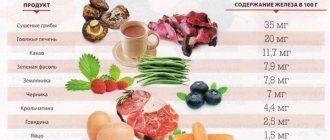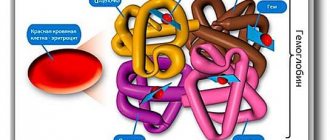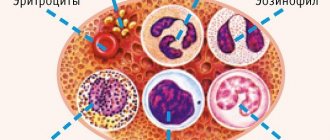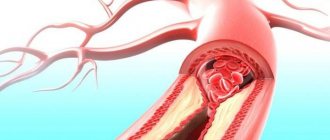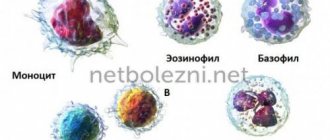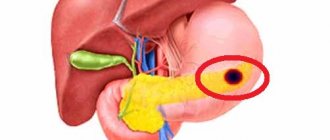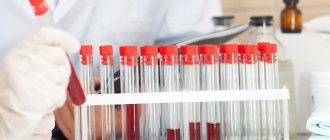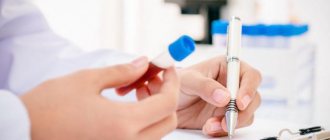The consequences of low hemoglobin are manifested in the development of anemia, due to a lack of iron in the blood. Low hemoglobin provokes a decrease in oxygen saturation of body tissues and places increased stress on functional systems. Hemoglobin transports carbon dioxide from the lungs throughout the body and helps normalize the acid-base balance in the internal environment.
A decrease in hemoglobin concentration worsens health, provokes dizziness, drowsiness, apathy and decreased blood pressure. Hemoglobin is a molecular compound of protein and iron in blood cells that not only fills the body with oxygen, but is also an important biochemical component for organic reactions. Due to a decrease in hemoglobin in the blood, oxygen starvation occurs in the body, which is called anemia or anemia.
Red blood cells
The norm of hemoglobin in a woman’s blood
The normal hemoglobin content in a woman’s body is insignificant, but lower than in men. These indicators are affected by:
- low presence of testosterone (and other male hormones), which helps with blood circulation in the body;
- monthly menstruation (blood loss).
Hemoglobin does not have one specific number. Its size depends on the woman’s age and lifestyle (bad habits, proper nutrition, sports).
- With a healthy body and a normal lifestyle in an adult representative of the fair sex, it varies from 120 grams to 140 grams per liter of blood.
- In children under 18 years of age, this figure shows from 115 grams to 155 grams per liter of blood. In old age.
- Starting at age 70, hemoglobin can drop from 115 grams per liter of blood to 160 grams per liter of blood.
- Those women who smoke or play professional sports have around 160 grams per liter of blood.
- Pregnant women feel great with figures ranging from 105 grams to 120 grams per liter of blood.
If suddenly the indicators do not fall within the specified interval (especially if hemoglobin is below 40 in women), you should think about possible serious diseases. To do this, you need to undergo an examination by a qualified specialist, pass all the tests, and most importantly, a general blood test. Only this will help make an accurate diagnosis of the disease and determine its cause.
Analysis algorithm
A general blood test will not require any special preparation from the patient. Donate blood without fail on an empty stomach - 8-12 hours after eating. During the period of forced fasting, it is allowed to drink only plain or mineral water. The most comfortable time for analysis is the morning hours. A blood test for glycosylated hemoglobin does not require preparation. It does not need to be taken on an empty stomach; you can drink anything before it, even light alcohol; you should not refrain from physiological or psychological stress; taking medications (except for diabetes medications) will not affect the results.
The technique for taking such a blood test is known, perhaps, to absolutely everyone. The laboratory technician takes the required volume of blood from the finger, and after a couple of hours you get the result. The collection form contains information about the number of erythrocytes and leukocytes, ESR and leukocyte formula.
Causes of low hemoglobin in women
Many health problems begin at an early age if you do not follow proper nutrition and lifestyle. The same applies to the state of hemoglobin in any organism. Why is hemoglobin low in women:
- poor nutrition, which does not contain enough essential vitamins and minerals for the body;
- lack of animal products in the body, the most common cases of low hemoglobin are when a woman is a vegetarian;
- heavy menstruation, during which biological fluid is lost in a very short time (and the body does not have time to replenish);
- chronic diseases lead to a lack of normal amounts of iron in the body;
- bad habits (smoking, regular alcohol in large quantities);
- various injuries, previous surgeries, as well as, for example, ectopic pregnancy;
- for the entire period of pregnancy and breastfeeding, the body needs a large amount of iron, and even more products containing iron, vitamins B12 and C are needed, which contribute to the absorption of iron into the body’s cells;
- after influenza and other serious infectious diseases;
- in the presence of worms that consume large amounts of vitamin B12;
- frequent stressful conditions.
Before drawing any conclusions based on this article, you should definitely contact codified specialists and take the necessary tests and a general blood test. Only in this case will it be possible to correctly determine the diagnosis and prescribe treatment.
Risks of low iron protein levels
Due to women's physiological changes, such as pregnancy, menstruation, menopause, their body loses iron.
In addition, hormonal surges and physical activity significantly increase the body's need for hemoglobin, which supplies the body's cells with oxygen.
Accordingly, the greatest need for oxygen is experienced by teenage girls, pregnant women and women over 45 years of age.
The danger of hemoglobin deficiency depends on the severity and neglect of this problem in the body.
For example, at the initial stage of anemia, it is enough to adjust your diet to correct the situation.
If the hemoglobin level is too low for a long time, then medical intervention and long-term restoration of the affected internal organs and body systems will be required.
In advanced cases, there is even a risk of death. Thus, every person needs to be attentive to the health of their body, not to cause the disease, taking adequate measures in time to correct the situation.
There are three main causes of anemia:
- insufficient intake of vitamin B12 and folic acid into the body;
- iron deficiency in the body;
- excessive destruction of red blood cells.
Caused by various reasons, low hemoglobin affects the female body in different ways.
From a very early age, with group B vitamin deficiencies, there is often a delay in the development and growth of the girl’s body.
Adolescence may be accompanied by fainting, poor health, increased pallor, and weakness.
Against this background, coordination is impaired and spasms of the limbs appear. The skin becomes dry and cracks, especially in the area of the hands and knees.
Due to insufficient oxygen supply to the digestive tract, pain in the stomach and larynx appears when swallowing, and internal ulcers of the stomach and intestines occur.
READ What are the reasons for a decrease in leukocytes in a child’s blood?
During pregnancy, a low level of hemoglobin disrupts its course, and sometimes leads to premature birth and developmental disorders of the child.
Due to a lack of iron in women's bodies, a significant decrease in immunity occurs, which leads to an increase in morbidity.
A feeling of constant weakness, frequent overwork, irritability, shortness of breath, neurological disorders, peeling nails, hair loss - all these are the most common external manifestations of low hemoglobin.
With hemolytic anemia, signs of jaundice, cholelithiasis may appear, and pain in the back and abdomen may worsen.
Heart failure gradually develops, often aggravated by fainting and fever.
Video:
The body stops resisting diseases. The liver and spleen increase in size and begin to wear out faster.
The dangers of low hemoglobin can be considered using the example of the functions of the heart and the immune system.
Due to a lack of oxygen, the heart begins to work with increased load, and heart failure occurs. There is a danger of death at any moment.
Decreased immunity makes the body defenseless against many infectious diseases, which with low hemoglobin occur with complications.
A decrease in iron-containing protein in the blood is especially dangerous for pregnant women and can affect the development of the fetus.
Oxygen starvation significantly increases the risks. In this case, it is better to focus on dietary nutrition and consult a hematologist.
Video:
Low hemoglobin symptoms in women
Like the causes, the consequences of low hemoglobin in women vary. But initially, when any disease develops, you can recognize what kind of illness it is by the symptoms.
Symptoms of low hemoglobin in the blood in women:
- unusual fatigue, even after light exertion;
- frequent headaches, sometimes dizziness;
- regardless of the amount of rest - regular drowsiness, possible weakness;
- low blood pressure.
More complex cases:
- changes in taste buds (desire to eat chalk, raw meat, sand, etc.);
- loss of consciousness;
- changes in the sense of smell (desire to smell acetone, paints, etc.);
- discomfort in the groin area (itching).
Externally, signs of low hemoglobin in women may appear as:
- hair loss (on average, in a normal state of the body, a person loses 50-120 hairs per day);
- dry skin, sometimes slightly yellowed;
- unusual fragility of nails and hair;
- possible wounds in the corners of the mouth.
Symptoms of low hemoglobin in women over 40 may also include:
- caries and unnatural color of tooth enamel;
- insomnia;
- problems with hearing in the form of noise.
Symptoms of deviation
If a woman has hemoglobin 100, this will definitely manifest itself. As this indicator decreases, the appearance deteriorates, so the deviation is noticeable even without laboratory testing.
Symptoms include the following:
- The skin becomes pale or bruises appear on it. The skin becomes dry and peels.
- Nails lose strength and break.
- Hair is falling out a lot.
- The face becomes puffy.
Hemoglobin 102 in women causes not only a deterioration in appearance. A person may also feel physically unwell. It manifests itself in the following:
- Weakness throughout the body, drowsiness.
- Fast fatiguability.
- Regular headaches.
- Dizziness.
- Lack of oxygen.
- Problems with blood pressure.
- Loss of consciousness.
Important! If such signs appear, it is recommended to urgently undergo a laboratory test and inform your doctor. You may need to take medications for anemia.
Headaches due to anemia
Low hemoglobin during pregnancy: causes and how to increase
During pregnancy, iron consumption in the body increases several times, causing hemoglobin to decrease. The child also takes in many other vitamins that contribute to the development of nutrients that affect the absorption of iron in the body. This is affected by:
- growth of the placenta;
- fetal growth (formation of new vessels, cells, etc.).
Therefore, pregnant women have low hemoglobin and it drops to 105 grams per liter of blood.
Reduced performance is also affected by:
- insufficient interval between pregnancies (in this case, iron simply does not have time to recover);
- diseases such as heart disease, inflammatory processes in the kidneys and liver, dysbacteriosis;
- stressful conditions.
It is necessary to increase hemoglobin levels, and pregnant women will be helped with this by:
- seafood (red fish would be an excellent choice);
- legumes (they can also be added to salads);
- all kinds of greens (cilantro, parsley, etc.);
- nuts (almonds, walnuts) and buckwheat;
- beef, beef liver.
It is also necessary not just the presence of iron, but microelements that affect its absorption throughout the body. After consultation with a specialist, he may prescribe medications that include the following vitamins :
- Vitamin C helps iron to be better absorbed;
- vitamin B12;
- Folic acid has a great effect on a woman’s gonads;
- Antioxidants are copper and manganese.
Important!! For cancer patients, the use of any medications (vitamins) is prohibited. Before doing this, you should definitely consult with your doctor.
What is necessary for the formation of hemoglobin?
- The food you eat should be rich in iron.
- Normalized absorption process in the small intestine and stomach.
- Animal protein must be present in the diet.
- It is necessary to take folic acid and vitamin B12. These components are responsible for the process of creating red blood cells in the bone marrow. Accordingly, with a decrease in the quantitative number of red blood cells, the hemoglobin level will begin to drop significantly.
- For the formation of hemoglobin, the absence of pathological conditions in the hematopoietic system is necessary. That is, no congenital or acquired blood diseases.
Red blood cells - normal and with anemia
Which doctor should I contact and how to treat low hemoglobin in a woman
What hemoglobin indicator can be found out by taking a general blood test (in some laboratories you can donate blood only for the required indicator). Blood is often taken from a finger, and in some cases from a vein.
To get tested, you can contact any independent laboratory or hospital near your place of residence. The family doctor can also issue a referral. A qualified specialist will prescribe the necessary treatment only after a complete history and examination of the patient. Based on tests, examinations and interviews, the doctor prescribes treatment and sets the necessary diet.
- In emergency cases (hemoglobin below 60), a blood transfusion with appropriate vitamins is prescribed. This procedure leads to the fastest possible restoration of the required hemoglobin level. However, this is considered a huge stress for the body, which is why it is rarely performed.
- Those who do not urgently need to increase hemoglobin can replenish the reserves of red cells in the blood with special foods with the maximum amount of iron. Also, do not forget about vitamin complexes, which also saturate the blood with microelements or help iron quickly absorb.
- If proper nutrition alone is not enough, you should consult a general practitioner or hematologist. The doctor will prescribe the necessary medications, which contain iron, or intravenous injections (like transfusion, the latter method is also prescribed extremely rarely, only in cases with advanced forms).
Carrot salad
To improve the composition of the blood, it is necessary to consume it constantly. It is made by grating large raw carrots on a large grater and adding two tablespoons of sour cream with a high percentage of fat and a pinch of salt to the vegetable mass. You need to eat this salad on an empty stomach. The shortest course is a month. Ideally, you should have breakfast with such a salad at least 2 times a week, even with normal blood composition, in order to prevent a decrease in the level of red blood cells.
Nutrition for low hemoglobin in women
All of the following products should be consumed along with vitamin C, which helps quickly absorb iron and normalize the functioning of red cells in the blood.
Products for low hemoglobin in women:
- chicken giblets, beef (in particular beef tongue);
- apples, pomegranate, strawberries, apricots, persimmons (freshly squeezed juices);
- new potatoes, buckwheat;
- greens, including spinach and lettuce;
- walnuts and legumes (can be added to salad);
- black chocolate.
However, before you start increasing hemoglobin, you need to find the reason for its drop. After all, treatment begins with the cause, and low hemoglobin is already a consequence.
What to do: treatment of anemia
Replenishing the lack of iron in the blood is not an easy task. When treating, it is necessary to take into account the causes of anemia, its severity, and the general health of the patient. Depending on the level of hemoglobin in the blood, there are 4 stages of anemia:
- Mild degree. Hemoglobin was slightly reduced, by 10-15% of normal.
- Average degree. Hemoglobin is 70-90 g/l.
- Severe degree. Hemoglobin is reduced to 40-50% of the required norm.
- Extremely severe and can be fatal. Hemoglobin decreases below 50 g/l.
Before treating anemia, you need to do a blood test. First, for a speedy recovery, it is necessary to eliminate the cause, and then restore the concentration of iron in the blood serum. For this, various medications, proper diet, folk tinctures and decoctions are prescribed. Let's look at the main methods of treatment for iron deficiency anemia.
Drug treatment. Nowadays, many drugs and iron injections have been developed that stabilize hemoglobin levels. But their dosage should not be high, so as not to cause intolerance. The daily value of iron varies from 110 to 300 mg. Side effects are possible when taking the medication: diarrhea, dizziness, vomiting, nausea. The course of treatment and medications should be prescribed by a doctor after diagnosing iron deficiency anemia.
Nutrition. With low hemoglobin, our body does not absorb vitamins and iron. To increase their concentration, you need to eat foods containing these elements. Iron can be divalent (found in meat) and trivalent (found in plant foods). During prolonged heat treatment of food, iron oxidizes and becomes unsuitable for hemoglobin synthesis. The best products are:
- meat - veal liver, boiled pork, lamb;
- solid cereals, buckwheat, oatmeal;
- greenery;
- fish, seafood;
- berries – mulberries, strawberries, blueberries;
- honey;
- raisin;
- eggs;
- fruits - pomegranates, bananas, apples, apricots, pears;
- green vegetables, radishes, beets, tomatoes;
- dairy products;
- juices – pomegranate, carrot, plum, beetroot, apple;
- mineral water.
Coffee, tea and foods that contain a lot of oxalates are prohibited:
- boiled beans;
- chocolate;
- spinach;
- strong broths;
- tangerines.
Folk remedies. There are many methods and recipes tested by the people that help with mild stages of anemia; some products help increase low hemoglobin. But such treatment must be agreed with a doctor. The most popular recipes for replenishing iron deficiency are:
- Every morning eat 100 grams of grated carrots with sour cream.
- Three vegetables to boost low hemoglobin. Grate carrots, beets, radishes in equal proportions and add 1 teaspoon of oil per 200 grams of vegetables.
- Rosehip infusion. Pour 250 grams of boiling water over 1 tablespoon of crushed fruits, let it brew for 6 hours, drink 1 glass a day.
Bottom line
And so, to summarize, we can say that the treatment of low hemoglobin in women depends directly on the cause of the disease.
Self-medication can only worsen the situation, so in any case, at the slightest sign of low hemoglobin, you should contact your doctor.
Low hemoglobin can be due to a lack of iron and essential microorganisms, or a symptom of serious diseases.
You can learn more about low hemoglobin , its symptoms, causes and dangers from other articles on the information site Vitaminstvo.ru. Also on this site you can find even more useful information about the human body, essential vitamins and proper nutrition.
It will be interesting to know:
Low levels of prolactin in women and men - causes and treatment Why are there streaks of blood in the stool in children and adults - let's understand the reasons PCR tests: how is the test carried out and for what infections? What does low testosterone mean in men and women?
- Find:
For adults
- Clinics
- Hospitals
- Hospitals
- Dispensaries
- Women's consultations
- Medical centers
- Maternity hospital
- Dentistry
- Private clinics
